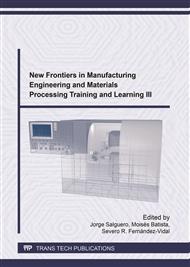p.56
p.63
p.70
p.76
p.84
p.92
p.100
p.112
p.120
Innovations in Learning and Teaching for Manufacturing Engineering under Ubiquitous Computing and Distributed on Mobile Devices Smartphones and Tablets
Abstract:
The new technologies of information and communication have opened up new possibilities for training in the field of manufacturing engineering. Information and communications technology contribute to flexible process of teaching and learning thanks to the ease of creating, processing and dissemination of content. They are also an opportunity to improve new learning environments, closer to actual production contexts. But to achieve an efficient process of learning, methodologies (that are based on ICT) should be adapted to the students’ characteristics, the contents and the context. This paper aims to design a model of teaching and learning from educational innovation with the use of information technologies applied to training Manufacturing Engineer using mobile devices as a teaching resource. The tool will be designed to self-education situated in learning contexts and incorporates different instructional strategies for student learning and teacher monitoring.
Info:
Periodical:
Pages:
84-91
Citation:
Online since:
August 2017
Price:
Сopyright:
© 2017 Trans Tech Publications Ltd. All Rights Reserved
Share:
Citation:


